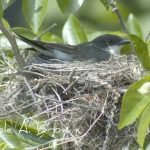In years past butterflies have been abundant in my Ecosystem Garden to the point where I wrote about Red Admiral Population Explosion and also Why Are There so Many Tiger Swallowtails this Year?
But this year butterflies of all kinds are much scarcer, so I celebrate each individual sighting.
I haven’t seen ANY Monarch Butterflies in my wildlife garden this year, despite the plethora of Milkweed I’ve planted for them.
In fact, I’ve only seen ONE Monarch Butterfly near my home, and that was a cause for celebration indeed! But it wasn’t until mid July when I observed this Monarch, and that is very late indeed.
So imagine my delight when I discovered a Red Admiral butterfly (Vanessa atalanta) sipping from a sap flow in the front garden this weekend!

Even though they’re well camouflaged when their wings are closed, there is a bright spot of orange and a beautiful spot of blue on the underside of the Red Admiral butterfly’s wings that caught my attention.
And I happily watched this beautiful butterfly for several hours. And even more exciting is that the Red Admiral butterfly has returned to this sap flow every day since.

The Red Admiral (Vanessa atalanta) is a species of butterfly found throughout much of the world, including North America, Europe, and Asia. It is a medium-sized butterfly, with a wingspan of around 2 to 2.5 inches. The wings are primarily black with bright red bands, which give the butterfly its common name.
The Red Admiral is a highly migratory species, and is often seen in gardens, parks, and other urban areas. It is particularly attracted to flowering plants and is often seen feeding on nectar from a wide range of flowers. The butterfly is also a frequent visitor to butterfly gardens, where it is attracted to nectar-rich plants.
The Red Admiral has a distinctive and recognizable appearance, making it a popular butterfly among amateur naturalists and professional biologists alike. It is a hardy species, capable of surviving in a wide range of habitats, including both urban and rural areas.
In terms of its life cycle, the Red Admiral undergoes complete metamorphosis, with four distinct stages: egg, larva, pupa, and adult. The caterpillar feeds on a wide range of plants, including nettles, hops, and willows. After pupation, the adult butterfly emerges and begins its short but active life, which may last up to two months.
Red Admiral adults prefer sap to any other kind of food, only coming to nectar at flowers when sap is unavailable.
The host plant for the Red Admiral butterfly is nettles, including Stinging Nettle (Urtica dioica), Tall Wild Nettle (U. gracilis), Wood Nettle (Laportea canadensis), False Nettle (Boehmeria cylindrica), Pellitory (Parietoria pennsylvanica), Mamaki (Pipturus albidus), and possibly hops (Humulus).
Unlike most other butterflies the Red Admiral spends the winter in adult form, and while not a long distance migrant like the Monarch, will move south to spend the winter in most of the southern states.
To create welcoming habitat for the Red Admiral and other butterflies in your wildlife garden, it’s important to understand the whole life cycle of each butterfly. Butterflies go through 4 stages: egg, caterpillar, chrysalis, and adult. And they need different things at each stage.

The Life Cycles of Butterflies, by Judy Burris and Wayne Richards is a wonderful resource to help you discover what each species of butterfly needs at each of these stages. This visual guide follows 23 of the most common butterflies from egg to maturity.
You’ll discover the correct host plants, life history information, identification photographs, and all the information you need to create your butterfly garden. You’ll see whether the butterfly overwinters as an egg, larva, pupa, or adult.
The Life Cycles of Butterflies is filled with stunning photographs of each stage of the butterfly’s life, range maps, and a wealth of natural history information. This is a book that just never seems to stay on the shelf, because I keep pulling it down to refer to over and over again.
More From Ecosystem Gardening:
Submit your review | |








